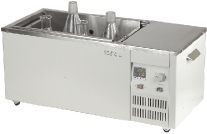Biological sample pretreatment-sample freeze-drying and conjugate hydrolysis
Biological sample pretreatment -Sample freeze-drying and conjugate hydrolysis 1.1 Sample freeze-drying Freeze-drying is an effective method for storing and pre-treating biological samples, but it is more targeted and is mainly suitable for a large number of samples with relatively high water solubility of the tested drugs. This method is also suitable for more volatile drugs. In addition, there is a case where some of the tested drugs need to be derivatized to be detected. If liquid-liquid extraction is used, sample concentration is required, which will cause the tested drug to decompose at a certain temperature. In this case, the freezing method is most suitable. The basic principle is to freeze the sample, and the water in it will form an ice shell and adhere to the surface of the sample, increasing the volatile area. Then put it into the freeze dryer to decompress, the ice will directly sublimate, and other impurities will also be evaporated. However, if the tested drug is too volatile, a part of it may be lost. When freeze-drying biological samples, they can be placed in an ice-acetone bath, liquid nitrogen or other low temperature conditions. Semi-solid samples such as feces, tissues, etc. can be placed in the freeze dryer with a freezing time of 1-10 minutes. 1.2 Conjugate hydrolysis After the second-phase metabolic reaction of the drug in the body, glucuronide or sulfate is often formed. Some drugs can not exist in a free state. If you want to detect the concentration of the parent drug, you need to hydrolyze it and then measure it. 1.2.1 Acid hydrolysis For acid hydrolysis, inorganic acids are usually used. For example, hydrolysis of conjugates in urine samples can be done by adding an appropriate amount of hydrochloric acid solution. As for the concentration of added hydrochloric acid, acidification time and heating temperature, it depends on the specific experiment. The hydrolysis of some drug conjugates requires mild experimental conditions, such as adding 0.5moL / L hydrochloric acid and leaving it for 15min, while others require violent experimental conditions, such as adding 3moL / L hydrochloric acid, it must be boiled for 1h. Acidic, add alkaline substances whenever necessary to adjust the pH value before drug extraction. 1.2.2 Enzymatic hydrolysis Enzymatic hydrolysis is a highly specific hydrolysis method. The most widely used hydrolytic enzymes are β-glucuronidase (β-glucuronidase) and arylsulfatase (arylsulfatase). Acid glycosides. The latter hydrolyzes the sulfate ester of the drug. A mixture of the two can also be used to hydrolyze both at the same time. Urine contains two substances, glucuronide or sulfate, so the use of mixed enzymes is more practical. The general steps are to control a certain pH value (4.5-7.0) according to the requirements of different enzyme reagents. After adding hydrolytic enzymes, anaerobic incubation for 16h . 1.2.3 Solvolysis The sulfate esters of certain drugs or endogenous compounds can decompose with the added extraction solvent during the re-extraction process, commonly known as solvolysis. It is also a milder hydrolysis method. For example, when the steroid hormone sulfate conjugate in urine is extracted by adding ethyl acetate at a pH of 1, it will decompose and the steroid hormone released will be extracted into ethyl acetate. The temperature of the hydrolysis reaction is very important. Some experiments also require shaking and shaking at the same time as the reaction. Our company can provide the following instruments. HWT series constant temperature water bath Instrument introduction HWT series constant temperature water bath is a conventional device for heating constant temperature in laboratory. It is now widely used in microbial clinical laboratory cultivation, constant temperature reaction, sample concentration and other routine experiments. main feature 1. Temperature adjustment adopts PID technology and digital display. 2. Advanced PTC heating element, stable temperature rise. Safe and reliable operation. 3. The surface of the device is made of stainless steel, which has strong corrosion resistance. 4. Touch adjustment buttons, temperature adjustment is convenient. Technical Parameters Model HWT-2BHWT-6BHWT-10BHWT-20B Temperature control accuracy (℃) ± 1 Temperature control range (℃) room temperature ----- 100 Temperature control mode 4 digit display / PID adjustment / overheat protection / PTC heating Heating capacity (L) 26 10 20 Slot size (mm) 150 × 135 × 100 300 × 150 × 150 300 × 250 × 150 500 × 300 × 150 Power supply (W) 150 240 300 800 Weight (kg) 1.55 9 18 HWT series constant temperature water bath shaker main feature 1. Brushless DC motor, low noise, no vibration, maintenance-free, and long service life. 2. Built-in feedback control system to ensure the stability of the speed. 3. Digital PID controller with automatic fine adjustment function to achieve precise temperature control and soft keyboard operation. 4. Optional reciprocating shaker orbital shaker. 5. Microcomputer control, touch buttons, temperature and speed LED display. 6. Independent over-temperature protection device. Technical Parameters Model HWT-10CHWT-20C Temperature control accuracy (℃) ± 1 Temperature control mode 4 digit display / PID adjustment / overheat protection / PTC heating Temperature control range (℃) room temperature ----- 100 Reciprocating Oscillation Heating capacity (L) 1020 Slot size (mm) 500 × 290 × 440730 × 330 × 460 Power supply (W) 11002100 Oscillation range (mm) 0-200-24 Speed ​​(rpm) 10-200 10-200 Whistling Tea Kettle,Best Whistling Tea Kettle,Yellow Whistling Tea Kettle Kingho Housewares.Ltd , https://www.kinghokettle.com


